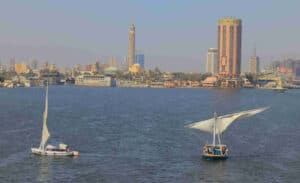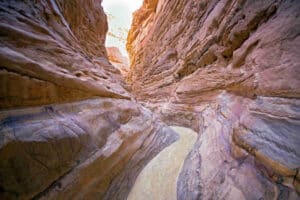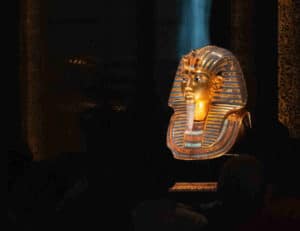The White Desert of Egypt is one of those places that seem to be taken out of a fairy tale or a science fiction movie. But it is real, and you can visit it, as do many of the travelers who put themselves in the hands of our agency. In this post we tell you what is special about this place, protected as a National Park at the beginning of the century, and we explain how to visit it.
What is special about the White Desert in Egypt?
As can be deduced from its name, what makes the White Desert different is its color. Of course, its arid terrain is sandy and stony, with mainly light brown tones. But superimposed on that base are spectacular white patches. This is because they are deposits of white chalk, both in the form of small mounds and authentic rock formations. Some of them, due to the effect of differential erosion, are torms that remain standing, with a narrow base and a wider cusp, giving rise to the most imaginative interpretations.
In other sectors it is possible to find fine sand dunes, which is probably what comes to mind when you think of a desert. But what is unique is that these sand dunes often coexist with the white chalk deposits, so that a most suggestive contrast is created, as if they were ‘rock waves’.
This almost lunar environment lends itself to the most diverse activities, such as 4×4 routes of the most exciting, but also to opposite proposals: meditation sessions, yoga and spirituality, because the stillness and silence that one breathes here invite to the introspection of oneself and the release of stress. And the clarity of the sky and the absence of cloudiness on most days also make the White Desert a perfect place for sky observation activities, especially astronomical tourism at night.
How to visit the White Desert: facts and information
The White Desert covers an area of about 300 km2: it is therefore a small section of the Western Desert, but it is still a very large area (e.g. twice as large as the Ordesa National Park in Spain). Its location is about 570 km southwest of Cairo.
The nearest town of importance, and from where most of the excursions are organized, is Farafra and its oasis, located about 45 km away. However, it is also very common to do this activity from Bahariya and its oasis, about 130 km away, but closer to Cairo (about 360 km) than Farafra (about 500 km).
It should be recalled that Egyptian law does not allow the establishment of camps and other structures in such a natural environment, but it does allow the movement and pitching of tents during the day and for a maximum of one night(overnight stay), which favors the organization of activities such as those discussed above.
And another important detail to take into account is its climate: in summer, during the day, the heat is simply scorching, exceeding 40º-50º, in addition to the fact that it is an environment without shade, so it is not advisable to travel here in the hottest months of the year. However, the spring and autumn months are perfect for this, and winter is also a good time. However, you should also keep in mind that the thermal oscillation here is very large, so that winter nights can become freezing, so it is advisable to wear appropriate thermal clothing.
Because the White Desert is huge and the road network is very poor, it is essential to travel this area in a 4×4. And a driver-guide who knows the terrain well should be at the wheel, so as not to lose orientation or get into places that are difficult to access. Therefore, putting yourself in the hands of an agency like Egypt Exclusive will help you to enjoy this experience safely.



